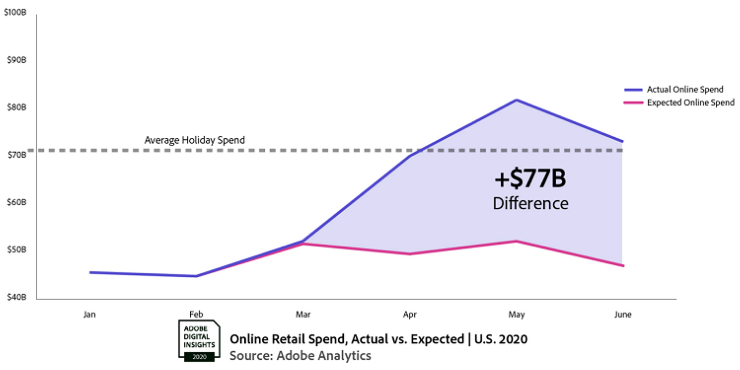What Could You Learn from 1 Trillion Retail Sites Visits and 100 Million SKUs?
In this blog post we look at the findings in Adobe’s Digital Economy Index, released at the end of June 2020. After we examine their observations of the larger trends, we highlight the key factors that drive success in today’s ecommerce winners. One of the key ones is putting in place the Customer 360 data platform. Within that, key elements include enhancing the customer experience with custom catalog search and real-time recommendations.
What’s Hot in eCommerce in 2020
Welcome to the second half of 2020; and surprising no one, shopping online is growing faster than ever. We began the year excited about all the possibilities; our friends at 451 had given us a lot to consider with their February Connected User Landscape study predicting multibillion dollar growth (or missed revenue) owing to how customer experience was orchestrated. (You can see highlights here: Figure 2).
But that was then, and this is now; what was once driving by convenience and selection is now for many their lifeline to provisioning household supplies during economic shutdowns.
Let’s look now to a recent Digital Economy Index report released by industry leader Adobe (and an enthusiastic Aerospike customer) for their insights into what the near future holds for those in making their livings in this segment.
The Adobe Digital Economy Index and eCommerce trends
Adobe has unique insight into the transactions of 80 of the top 100 retailers on the web in the U.S. via their Adobe Analytics / Experience Cloud system. This data is an aggregation of anonymous data from over 1 trillion visits to retail sites and over 100 million SKUs. These observations are paired with observations based on a research survey of 1,000 U.S. consumers (18 years or older) fielded in June 2020.
It is from this treasure trove of information that they compile the Adobe Digital Economy Index (DEI) is a global economic measure for the 21st century that more quickly, comprehensively, and internationally measures the patterns and trends of digital consumers.
Key findings:
US consumers have shifted a significant part of their shopping online. Compared to previous predictions for the Mar-Jun period, $77B extra has been spent online (see Figure 1.)

Figure 1: A visual representation of the difference the pandemic and resulting economic / social changes have made on the patterns of seasonal online shopping. (Q2 has never been above holiday levels before.)
Ecommerce shopping levels are tracking at above holiday (Nov-Dec) levels, the $77B equates to more than half of the 2019 holiday season in additional spend.
The first 6 Months of 2020 have had $368.8B in online spend with June generating $73.2B, up 76.2% YoY.
Taking a step back, let’s look at facts about online shopping that pre-date the current situation as outlined in the DEI.
For several years now, the digital economy has been growing faster than the economy as a whole. Given global supply chains and trade agreements, inflation has been historically low — in no small part influenced by falling prices online. Online shopping has been converging with offline as click-and-collect, one-day shipping, and other services let people transact with greater ease and convenience for a wider variety of goods and services. Online shoppers are accustomed to being able to compare and buy products around the world and have them shipped to their door. (Ergo, savvy e-commerce companies have come to expect competition from around the world.) And, mobile shopping has allowed people to shop and buy from anywhere in the world at any time with rapid reduction in friction.
Changes to eCommerce trends since March 2020
Online shopping has become the primary means of commerce populations around the world as purchases previously made in person are shifted online. With a corresponding shift towards items related to health, working from home, and social distancing. Companies are adjusting to daily changes in demand, supply, and labor availability. Those with a fast data layer are the winners when it comes to providing custom personalization, recommendation, and the most accurate information about available products and delivery speed.
For more details on the topics of digital purchasing power, trends in grocery, apparel and computer trends, go to the DEI itself. (Spoiler: recent deflation in these categories is at an end for the time being.)
Keys to success eCommerce in 2020 and beyond
If you are in charge of increasing your shopping cart size or enhancing the overall online shopping experience, let us summarize a few insights that we have gleaned (including best practices in building your Customer 360 and ML AI learning platforms)
Provide in-the-moment personalization.
Just because the consumer has to shop online, doesn’t mean they have to shop with you. Being able to provide sub-millisecond response time, and the best possible recommendations and suggestions is ‘table stakes’. (In-store retailers have honed and perfected the art of the checkout aisle impulse purchase; these moments that matter are your “next best move.”)
Develop in-depth customer profiles built from collections across data silos and clouds.
Aerospike helps unify and activate these profiles for engagement at the edge, accessing at millisecond speed and petabyte scale, along with unmatched uptime.
Glean real-time insights from both full historical and edge data.
This will allow you to track changes in interest of what kind of products people are shopping for; and be on top of other key issues for customer satisfaction (product availability, delivery availability, user feedback and more.)
In Conclusion: Use today’s insights to take charge of your organizations’ future success.
We’d love to offer you further details on how to put the above three recommended strategies into action.
Get the latest on how Adobe has utilized the Aerospike and enabled competitive advantages with full use of edge data (1 Trillion visits….) by watching
their talk at our 2020 virtual user summit.
If you want an example of how a world leader (w/ 350 Million active customers) managed to break down data business system silo barriers and build record shattering new business growth, listen to Airtel CIO Harmeen Mehta describe building her organizations “
(Yes, eCommerce leaders can and should learn from the fast growing Telco segment.)
If you need to put in place a strategy to marry your offline data architecture into today’s online world, see what our Chief Strategy Officer Lenley Hensarling and Wayfair’s Chief Architect suggested earlier this year.



